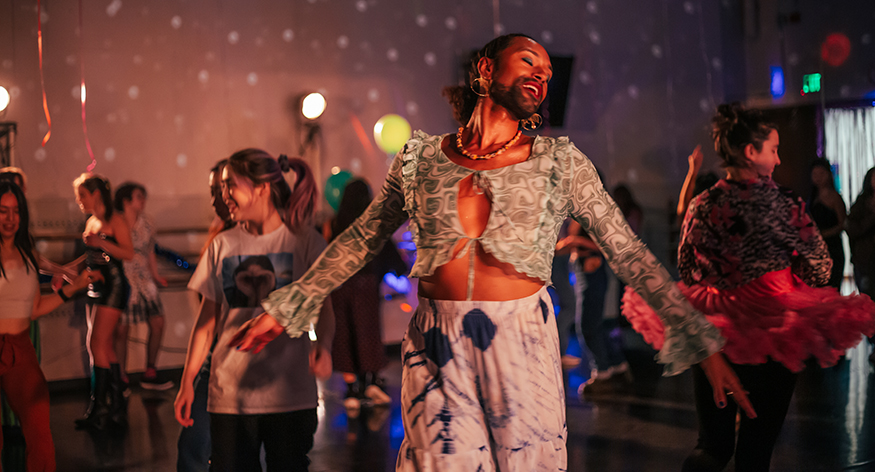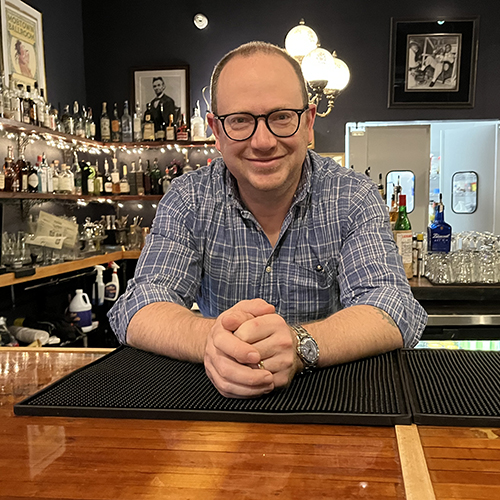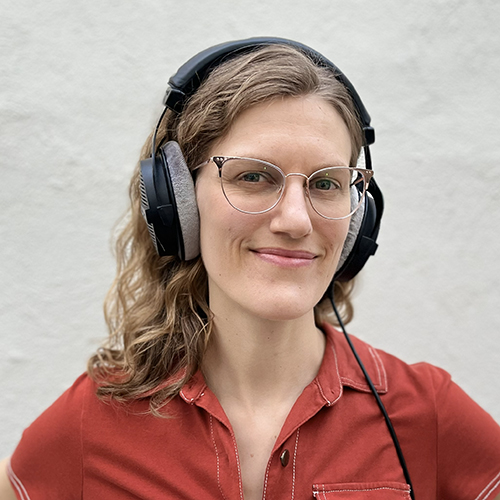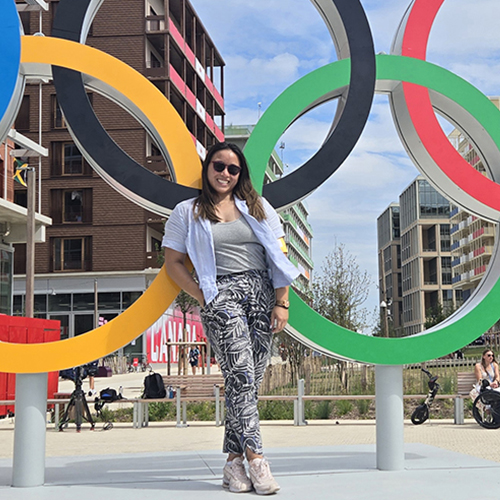
Before coming to the University of Washington for an MFA in dance, Abdiel Jacobsen lived several lives as a professional dancer: Ballroom dance instructor and competitor. Principal dancer with the renowned Martha Graham Dance Company. Advocate for the Latin Hustle, a partner dance that peaked in popularity in the 1970s.
It was the hustle that led Abdiel (they/them) to graduate school. They had been researching the history of the popular dance form — which got its start in the Latinx communities of New York’s South Bronx — and saw the MFA in dance, in the UW College of Arts & Sciences, as an opportunity to take that work to the next level.
“What social dance and hustle in particular have given me is so special,” Abdiel says. “I really wanted to go deeper.”
From Living Room to Stage
Dance has always been part of Abdiel’s life. Born in Ivory Coast and raised in Florida and Maryland, some of their earliest memories involve dancing in the house with their mother and sisters. At age eight, Abdiel began performing publicly with their sisters as the dance group Akwaba, which means “welcome” in Bété, their mother’s native language. Akwaba performed at school events, weddings, parties, and Black History Month celebrations all the way through Abdiel’s high school years. Still, they did not envision a career in dance — until serendipity led to unexpected opportunities.
In high school, a family friend convinced Abdiel and a sister to sign up for a free class at the local Authur Murray Dance Studio, which earned the friend a free private lesson. The siblings loved the class so much they signed up for more. The owner of the studio, Linda Theiss, saw how they took to ballroom dance and recruited both siblings as ballroom instructors after their third visit.
“She said we were talented and she loved our personalities,” Abdiel recalls. “She saw it in us. That summer I trained intensively and was certified professionally to teach soon after.”
That experience gave Abdiel the confidence to audition for the dance program at the University of the Arts in Philadelphia, competing alongside applicants with years of training in ballet, contemporary, and other dance styles. “I performed a solo that was a mixture of African dance and my own take on modern and contemporary dance. I had no technique in modern and contemporary dance,” Abdiel says with a laugh. “But I had so much drive and passion for dance. I knew this was what I had to do.”

Faculty at the audition knew it too. Abdiel was accepted into the program with a scholarship and thrived. Martha Graham Dance Company took notice and invited Abdiel to join its company after graduation, where they soon became a principal dancer.
During Abdiel’s seven years with Martha Graham, they spent eight hours a day in demanding rehearsals. But at night, when the other dancers went home to soak their aching muscles, Abdiel headed to dance clubs.
“I know, what was I thinking?” they laugh. “But I needed an outlet. As a principal dancer with Martha Graham, you hold this beautiful responsibility to the art and the legacy of a genius. Performing at that level, there’s so much demanded of you. It’s hard to let go and just enjoy it sometimes. At the clubs and at dance socials I could move however I wanted and just have fun. Even though I was exhausted physically, spiritually I was so alive.”
Creating Community through Hustle
It was in those clubs and dance socials that Abdiel discovered hustle. For Abdiel, it was love at first sight.
“Everybody was intermingling: gay, straight, queer, Asian, white, Black, brown. And there was a gender fluidity: men with men, women with women, women leading men,” Abdiel recalled in a Seattle Times story about hustle.
Ask Abdiel to describe the dance and their eyes light up. “Hustle has a beautiful continuous flow of motion, both circular and linear,” they say. “It has incredible dynamism, that Latin sabor, with the rhythm and the body isolation and the syncopation of the feet.” Abdiel also likes that hustle is a hybrid that pulls from many dance styles -- mambo, salsa, swing, smooth ballroom, and more. Any gender can lead or follow, which has always been its tradition.
It is so important to get back to the childlike joy of dance. Never lose that connection with why you dance in the first place.
Films like Saturday Night Fever catapulted the dance to greater prominence in the late 1970s, which proved detrimental to hustle’s image. “That period brought a whitewashed, mass-commercialized version of hustle that misrepresented the culture, the people, the dance, everything,” Abdiel says. “So many people think of the finger pointing of Saturday Night Fever when you say ‘Do the hustle.’ And that’s the furthest you can get from this dance.”
During the pandemic, Abdiel was determined to introduce more people to the joy of hustle. In February 2021, they and DJ Natasha Diggs co-founded “Dance is Life,” a series of hustle dance parties in New York’s Central Park, open to all. (See sidebar.) That same year, recognizing the dearth of information about hustle’s past, Abdiel began a documentation and preservation project for hustle, interviewing living legends of hustle to explore the history of the dance from its early pioneers — hustle's generation of dancers from the 1970s.
At the UW, Abdiel continued that historical research in the Department of Dance, in collaboration with Sarah Nguyen, a doctoral student in the Information School with a background in archival preservation. Based on their research, Abdiel created a dance studies course about the rise and revolution of disco and hustle in 1970s New York City.

Abdiel has also taught numerous studio dance courses at the UW. But the studio setting never felt quite right for hustle, which thrived in dance clubs. Abdiel’s solution was to create Club Classroom, an approximation of a dance club in a UW dance studio. Twice each quarter, a rehearsal room is transformed into a dark space with multicolored sidelights, a ceiling crowded with balloons, a deejay (DJ), and — of course — a twinkling mirror ball. The events are joyous affairs, open to the entire Seattle community across generations, identities, and abilities.
“I wanted students to experience hustle in a club environment, like I did,” Abdiel says. “In oral histories with pioneers of hustle, they say a big moment for them was walking into a club and seeing that mirror ball and how that circular lighting fixture gyrates. And then with the DJ spinning and improvising and playing dance music, there’s a call and response that goes on with the dancers, the DJ, and the music. These are integral tools used to improvise and play and practice.”
Club Classroom also enabled Abdiel to conduct a research project on the links between light, sound, and movement within a dance club environment, in collaboration with Nguyen and Julian Freedland, a doctoral student with an interest in cortical neuroscience.
Abdiel will create another Club Classroom in the coming year, when they join Scripps College as an assistant professor. They could not have anticipated a career as a professor years ago, dancing in their childhood home, but a passion for dance guided them.
“If there’s any advice I can give to dancers and other artistic performers, it’s that it’s so important to find your joy,” Abdiel says. “It is so important to get back to the childlike joy of dance. Never lose that connection with why you dance in the first place.”
More Stories

A Love of Classics and Ballroom
Michael Seguin studied Classics at the UW and now owns Baltimore's Mobtown Ballroom. The two interests, he says, are more connected than they might seem.

Bringing Music to Life Through Audio Engineering
UW School of Music alum Andrea Roberts, an audio engineer, has worked with recording artists in a wide range of genres — including Beyoncé.

A Sports Obsession Inspires a Career
Thuc Nhi Nguyen got her start the UW Daily. Now she's a sports reporter for Los Angeles Times, writing about the Lakers and the Olympics.
